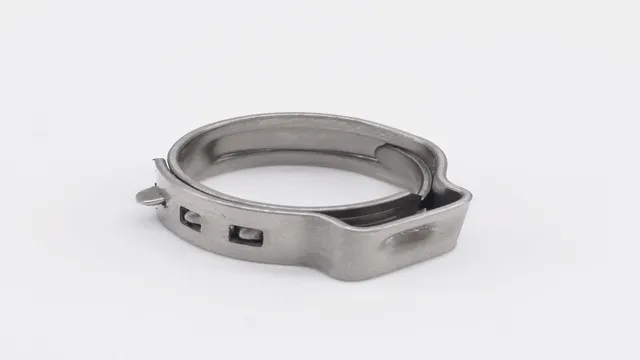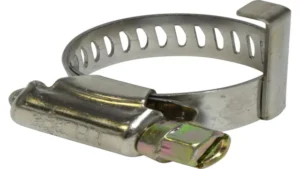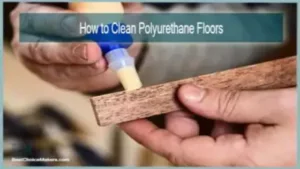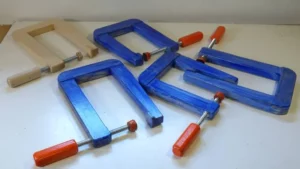Are you confused about how tight hose clamps should be? It can be daunting to know just how much pressure is needed to secure a hose without causing damage. Over-tightening can lead to hose damage or leaks, while under-tightening can result in leaks and hose slippage. So, what’s the sweet spot? In short, it depends on the type of hose you’re working with and the pressure it will be subjected to.
Think of it like tightening a lid on a jar – you want it secure enough to keep the contents inside, but not so tight that you can’t open it later. In this blog, we’ll explore the factors that impact how tight hose clamps should be and give you some general guidelines for achieving the right amount of pressure.
Understanding Hose Clamps
When it comes to hose clamps, the question often arises: how tight should they be? Well, the answer depends on the type of hose and the application. Generally, a hose clamp should be tight enough to prevent leaks but not so tight that it damages the hose or the clamp itself. Over-tightening can lead to the hose being pinched, which may cause a leak or even a rupture.
On the other hand, if the clamp is too loose, the hose may slip off the fitting or allow air to enter. To ensure you have the correct tension, it is best to refer to the manufacturer’s instructions or consult with a professional mechanic. Additionally, be sure to check the clamps regularly to ensure they remain secure and in good condition.
With the right tension and maintenance, hose clamps can effectively secure hoses and prevent leaks in your system.
Types of Hose Clamps
Hose clamps are essential tools for keeping hoses securely fastened in place. There are various types of hose clamps, each designed for specific applications and purposes. For instance, worm gear clamps are commonly used in automotive and plumbing applications due to their ease of use and adjustable nature.
On the other hand, spring clamps are ideal for low-pressure applications like securing vacuum hoses. T-bolt clamps are more durable and heavy-duty than other types and are suitable for high-pressure applications like turbocharger connections. Additionally, there are pinch clamps and ear clamps, both of which are ideal for automotive applications.
Understanding the different types of hose clamps and their respective uses is crucial in choosing the right clamp for your specific needs. By using the right hose clamp, you can ensure a secure and leak-proof connection between hoses. So, it’s essential to choose wisely when selecting a hose clamp.
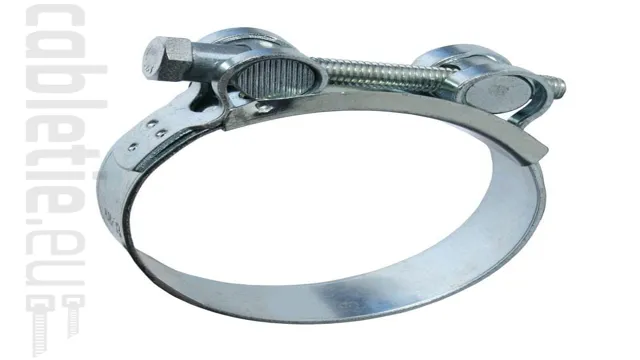
Importance of Proper Installation
When it comes to installing hoses and ensuring the proper flow of liquid or gas, hose clamps play an important role. Hose clamps are used to secure a hose onto a fitting, preventing any leaks or pressure drops. Understanding the different types of hose clamps is crucial for proper installation.
Worm gear clamps are a common type of hose clamp and are typically made of stainless steel. T-bolt clamps, on the other hand, are commonly used in high-pressure applications and have a wider range of sizes. It’s important to choose the right size and type of hose clamp to ensure a secure and leak-free connection.
Furthermore, proper torque specifications should be followed when tightening the hose clamps to avoid overtightening or undertightening, which can lead to failure of the connection. Overall, knowing the basics of hose clamps and their role in proper installation can go a long way in maintaining the safety and efficiency of industrial operations.
Determining the Right Tightness
When it comes to hose clamps, it’s important to get the tightness just right. If the clamp is too loose, the hose won’t be properly secured, and leaks can occur. On the other hand, if the clamp is too tight, it can damage the hose or even cause it to burst.
So, how tight should hose clamps be? The answer depends on the type of hose being clamped and the environment it will be used in. Generally, a good rule of thumb is to tighten the clamp until the hose is secure but still able to move slightly. If the hose is too loose, tighten the clamp a bit more, but be sure to avoid over-tightening.
You don’t want to damage the hose or create a situation where the clamp is under so much pressure that it could snap. Overall, finding the right tightness is all about balance – snug enough to prevent leaks but not so tight as to cause damage.
Factors to Consider
When it comes to wearing tight clothing, it’s important to consider the right fit. You’ll want to choose a tightness level that feels comfortable and complements your body shape. Keep in mind that too tight can be restrictive and uncomfortable, while too loose can fail to accentuate your figure.
To get the right fit, try on the clothing and move around in it to get an idea of how it feels. Pay attention to areas where the clothing may be too tight or too loose and adjust accordingly. It’s also important to consider the material of the clothing – some materials may feel more restrictive than others even if they are the same size.
Ultimately, the right tightness will depend on your personal preference and the occasion. Whether you’re headed to the gym or out on the town, choose a tightness that makes you feel confident and comfortable.
Using a Torque Wrench
Using a torque wrench properly is crucial when tightening bolts or nuts to avoid damage or accidents. One of the essential factors to consider is determining the right tightness required for the specific application. Over-tightening can cause bolt or nut failures, while under-tightening can lead to loosening and inadequate performance.
Thus, it is essential to follow the manufacturer’s specifications and recommendations for the correct torque settings. One can use a torque wrench to tighten bolts or nuts accurately to the manufacturer’s specifications and ensure that the bolted joint will perform as intended. A good practice is to apply torque in increments until reaching the final setting, checking after each increment to guarantee that the correct torque is achieved.
By doing so, one can guarantee a secure fastening and prevent any potential damage or accidents.
Using Visual Cues
When it comes to determining the right tightness for any given task, visual cues can be incredibly helpful. For example, if you’re trying to tighten a bolt, you’ll need to tighten it until it’s snug but not too tight. To do this, you can look for specific visual cues, such as the amount of resistance you feel when you turn the bolt or the amount of gap between the different components of the bolt.
Similarly, if you’re working with a material like wire or rope, you’ll need to ensure that it’s tight enough to do its job but not so tight that it becomes damaged or stressed. Again, you can rely on visual cues to help you determine the right level of tightness, such as the appearance of the wire or rope, its level of tension, or the sound it makes when you apply force. By paying close attention to these visual cues, you can ensure that your work is both effective and safe.
Troubleshooting
If you are wondering how tight hose clamps should be, the answer is “just tight enough.” Hose clamps are an essential component of any plumbing system as they keep hoses securely attached to fittings and prevent leaks. However, over-tightening hose clamps can cause damage to the hose or fitting.
On the other hand, if the clamp is too loose, the hose can slip off, causing a messy and potentially dangerous situation. Usually, you should tighten hose clamps until they feel snug, but avoid over-tightening. A torque wrench can be useful for achieving the correct level of tightness.
It’s also important to check the clamps periodically for signs of wear or looseness and re-tighten as necessary. Proper use of hose clamps can prolong the life of your plumbing system and ensure that it functions safely and efficiently.
Symptoms of Loose Hose Clamps
Loose hose clamps can cause a lot of trouble for your car, leading to a number of symptoms that can indicate their malfunction. One of the most common signs of loose hose clamps is coolant leaks. This could happen due to the poor grip of the clamps on the hoses, causing them to slide off and release coolant.
If you notice any puddles or stains of green or orange liquid under your car, it could be an indication of this problem. Another symptom that can indicate loose hose clamps is overheating of the engine. This happens when the coolant is prevented from flowing into the engine properly, leading to an increase in its temperature.
Additionally, you may hear unusual noises emanating from the engine, indicating loose hoses getting bumped around by the moving parts. These sounds can be described as squeaks, rattling, or whistling, depending on their intensity and type. In summary, if you notice any of these symptoms, it is time to get your car inspected and fix those loose hose clamps before they cause any further damage.
Symptoms of Over-Tightened Hose Clamps
If you have been having problems with your system lately, and you suspect that over-tightened hose clamps might be the issue, it’s important to know what to look for. One common symptom of over-tightened hose clamps is leaks. If you see any fluids dripping from your system, it’s possible that the hose clamps are too tight.
Additionally, if you hear unusual sounds coming from your vehicle, it could be an indication that the hose clamps are over-tightened. You might also notice that your engine is running hotter than usual, or that you’re experiencing a loss of power. If you suspect that your hose clamps are too tight, it’s important to have them adjusted immediately to avoid any further damage to your system.
Running your system with over-tightened hose clamps could potentially cause a catastrophic failure, leading to costly repairs or even a complete system replacement. Don’t take the risk – get your system checked today!
Conclusion
In the world of hose clamps, tightness is key but not to the point of causing structural damage like crushing or cracking the hose. Think of it like a hug from your grandma: firm but gentle enough that you can still breathe. Too tight and the hose may not function properly or, even worse, burst.
Too loose and the hose may slip off its connections, causing leaks. So let’s all take a cue from Grandma’s hugs and find that perfect balance of snugness for our hose clamps.”
FAQs
1. What is the purpose of hose clamps? A: Hose clamps are used to secure hoses onto fittings in order to prevent leaks. 2. Can over-tightening hose clamps cause damage? A: Yes, over-tightening hose clamps can cause damage to both the hose and fitting. It can also lead to leaks if the clamp becomes distorted. 3. How do I know if my hose clamp is tight enough? A: A hose clamp is tight enough when it is snug and doesn’t move easily by hand, but without distorting the hose or fitting. It’s best to follow the manufacturer’s recommended tightness specifications. 4. Should I use a torque wrench to tighten hose clamps? A: It’s not necessary to use a torque wrench, but if you want to ensure that you’re tightening the hose clamp to the exact specifications, then a torque wrench can be helpful. 5. What happens if I under-tighten a hose clamp? A: If a hose clamp is under-tightened, it can lead to leaks and potentially cause damage to the hose and/or fitting. 6. Are there different types of hose clamps? A: Yes, there are various types of hose clamps, including worm gear clamps, spring clamps, and ear clamps. 7. Is it necessary to replace hose clamps regularly? A: It’s a good idea to inspect hose clamps regularly and replace them if they appear worn, corroded, or damaged. It’s also recommended to replace them if you’re replacing the hose to ensure a secure connection.
